Dali Monitor Service

The Dali monitor job of EIBPORT V3 can be exclusively used in combination with Dali Gateway ABB DG/S1.1 to monitor illuminate and associated electronic ballasts on defect. ABB DG/S1.1 disposes of 2 channels (channel A and channel B), which can control 64 user each. For each channel, one Dali monitor job can be applied. For this purpose, the communication objects “Subscriber” (7/25), “selection failure illuminate” (15/33), “selection failure ballast” (16/34) (figure 153) of ABB DG/S1.1 ETS application will be required.

Required communication objects of Dali Gateway ABB DG/S 1.1
Functional schematic of Dali gateway ABB DG/S1.1
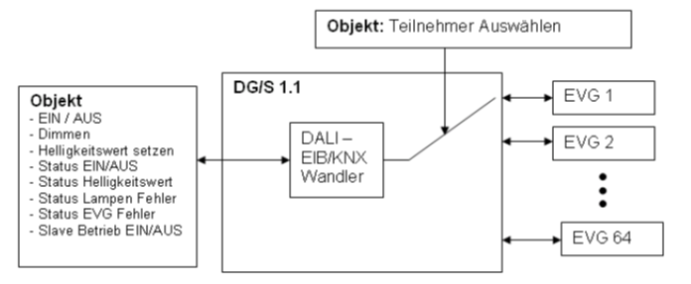
For each Dali monitor up to 64 outputs can be configured.
Job configuration
To apply a new Dali monitor job, either button in the menu bar of Job editor or a right click on the job container (“Dali monitor”) can be used.

Job Editor Classic - Dali Monitor job mask
Job Name
Required field. Assign a unique name for the job. The name must not contain more than 15 characters.
Gate Group Addresses
By Gate Group Addresses job will be released or blocked. The release object releases or locks the job. It is about an EIS1 object:
Field blank = Job is released.
Field completed, value 1 = Job released.
Field completed, value 0 = job locked.
Field completed, no value = job locked.
As soon as one address is filled in, release will behave respective to the value of the group address. If no value was sent to the address and the address is presently without values, job will be blocked.
Trigger Inputs

Dali Monitor – Job mask Trigger Inputs
Check all outputs (EIS 14)
Mandatory field. By this object, job will be triggered and all configured outputs will be checked.
Check one output (EIS 14)
With the help of this object (EIS 14), the job can be started for chosen outputs, by selecting the desired outputs in visualization element of Dali monitor.
Communication to Dali Gateway

Dali Monitor – Job mask Communication to Dali Gateway
Dali Gateway
Mandatory field. Selection of the connected Dali Gateway.
Request index (EIS 14)
Mandatory field. By this object the Dali-subscriber which should be requested is selected. Here the communication objects no. 7 resp. 25 „selecting subscriber“ out of ETS-application has to be entered (see figure 152 above).
Response Ballast (EIS 1)
Mandatory field. By this object a malfunction message of the previously selected Dali-subscriber can be read out (e.g., for maintenance purposes).
The communication object no. 16 resp. 34 „selection ballast fault“ out of the ETS application (see figure 152 above) has to be filled in here.
Response Lamp (EIS 1)
Mandatory field. Here the communication object no. 15 resp. 33 “selection lamp fault” out of the ETS-application (see above figure 152) must be filled in.
Fault addressed (DPT237.600)
Mandatory field, ABB DG/S x.64.1.1; Entry for the group address object 21 from the application program.
Number of faults statistic (4 Byte)
Mandatory field ABB DG/S x.64.1.1; Entry for the group address object 22 from the application program.
Result outputs
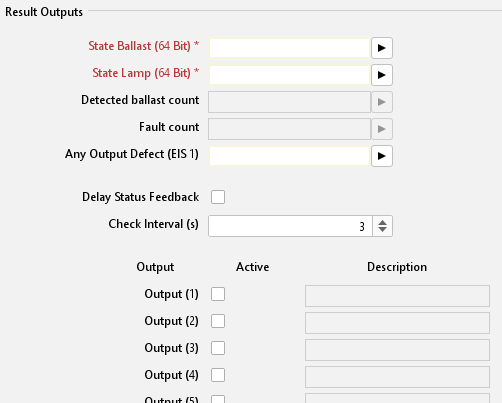
Dali Monitor – Job mask Result Outputs
State Ballast (64 Bit)
Mandatory field. This object serves for connection the Dali monitor’s ballast state with the column ballast of the Dali monitor’s visualization element.
State Lamp (64 Bit)
Mandatory field. This object is used for the connection of Dali monitor’s lamp state with the column “lamp” of the Dali monitor’s visualization element.
Defected ballast count
Not active with ABB DG/S 1.1; the number of faults is output via this object.
Fault count
Not active with ABB DG/S 1.1; the number of intact ballasts is output via this object.
Any Output Defect (EIS 1)
This object serves for linkage of optional malfunction or warning messages, to e.g., draws the intention to the necessary replacements of a ballast or a lamp.
Delay status feedback
This flag only concerns for the feedback message of the “Request all outputs” process. If this flag is set, state information only will be sent, when all enabled outputs are checked before. By this the bus load has been reduced distinctly during the request.
Check interval (s)
The interval time between each query can be situated between 1 and 10 seconds. Predefined are 3 seconds.
Output
It is possible to check up to 64 outputs per job.
Active
Output will be enabled or disabled (greyed out) for processing. At least one output must be enabled for a correct function.
Description
Optional. A description for each output can be made, for example the name or location of the ballast and the lamp being checked.
Example
Out of ETS-application of Dali gateway DG/S1.1, following objects are necessary:
No. 7
“Subscriber” with address 15/0/17No. 15
„Selection malfunction lamp“ with the address 15/0/19No. 16
“Selection malfunction ballast” with the address 15/0/20
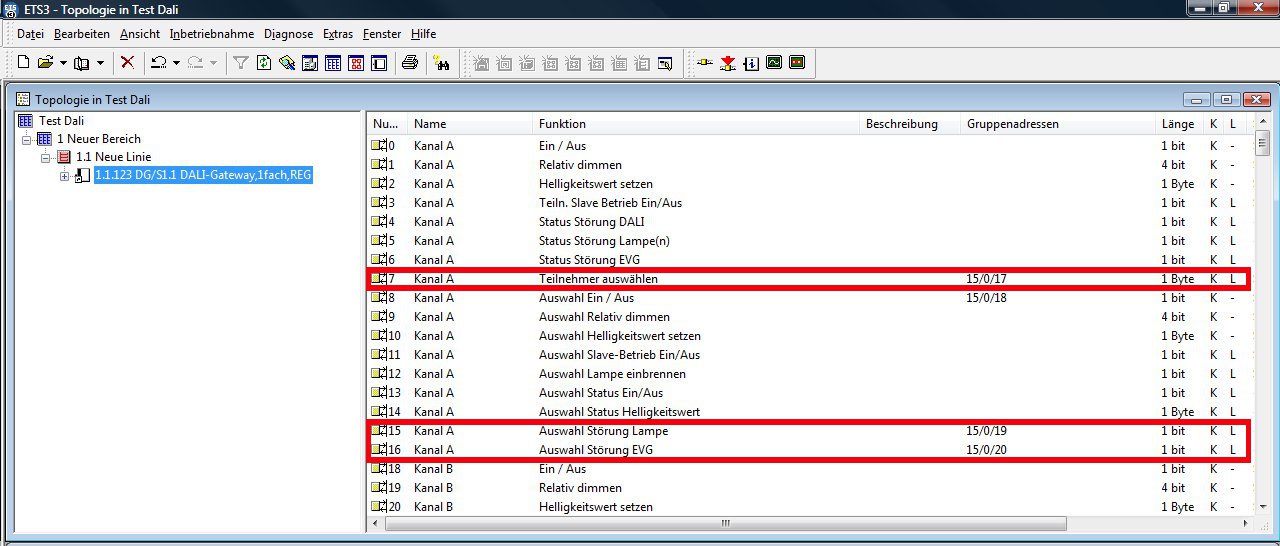
ABB Dali Gateway DG/S1.1 ETS application
Open a new Dali monitor job and assign a unique name, for example floor 1 right side.
Enter a group address at „Trigger Inputs“ for „Check all outputs“, by which you want to trigger this job. Optionally you can also assign a group address for “Check one output”.
Addresses out of ETS application have to be entered at “Communication to Dali Gateway”
No. 7
“Select Subscriber” by address 15/0/17 in “Request index (EIS 14)”,No.16
“Selection malfunction ballast” by address 15/0/20 in “Response Ballast (EIS 1)”, andNo.15
“Selection malfunction lamp” with address 15/0/19 in “Response Lamp (EIS 1)”.
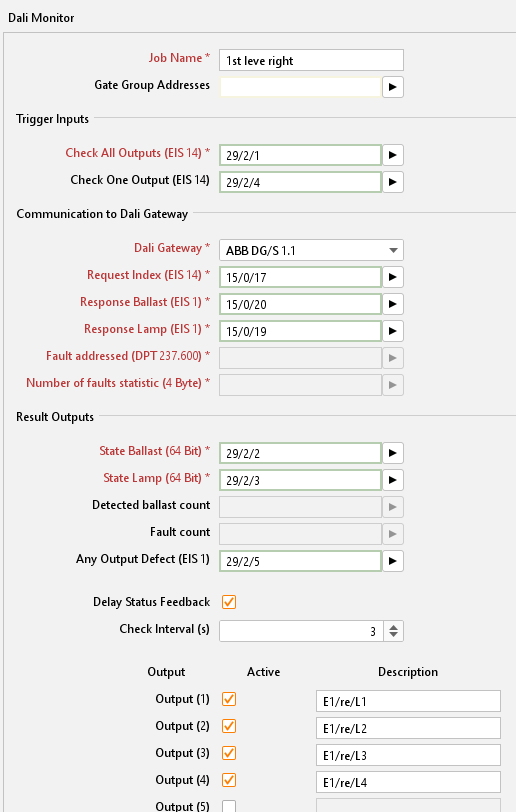
Dali Monitor job example configuration
To do the linkage between the job and the visualization element the addresses at “Result Outputs”, “State Ballast (64Bit)” and “State Lamp (64 Bit)” are used. To avoid an unneeded increase of bus load, please assign virtual group addresses (chapter 4.1).
Assign unique descriptions of outputs for an easy identification.
To display the results of the Dali Monitor Job in the visualization the “Dali Monitor” visualization element has been used. In the parameters of the “Dali Monitor” visualization element you simply choose the corresponding Dali Monitor Job by its name (chapter 5.6.1.).
The different colours of Dali monitor’s visualization element will give a state indication of requested ballasts and lamps.
Example:
On lamp 2, illuminate is defective, which is marked in red. On lamp 4, the ballast is already damaged, so that not any further check on the illuminate has been made.
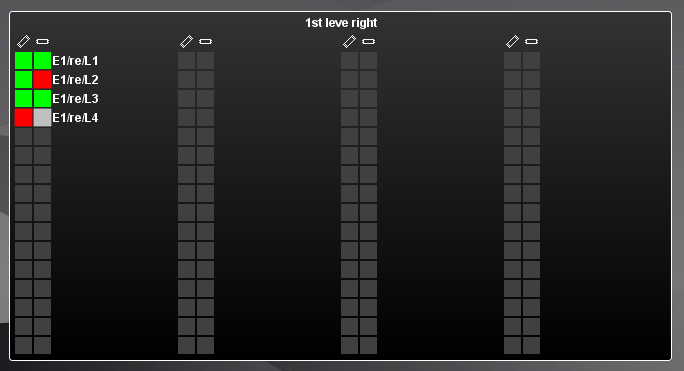
Dali Monitor in the Visualisation
